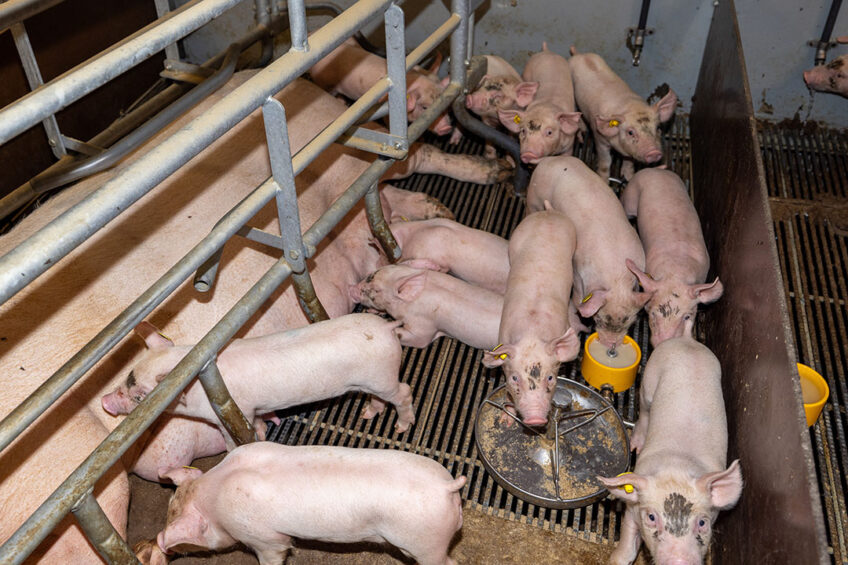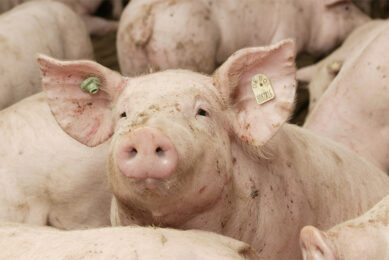Less protein in feed improves gut health in post-weaning piglets

Researchers from Italy investigated the effect of the dietary protein level on piglet growth and post-weaning diarrhoea.
The post-weaning period is a challenging period in a pig’s life affecting gut health and function. The changes in diet accompanied by morphological and enzymatic maturation of the gut mucosa may negatively affect digestion and absorption. In addition, piglets are in a rapid growth phase, thus they have a larger protein requirement than the gut digestion capacity. However, undigested proteins allow the proliferation of pathogenic bacterial flora that produce toxins and cause diarrhea. Therefore, the quantity of protein fed to piglets plays a leading role in gut health and function after weaning.
Data collection
The researchers used 144 weaned piglets (Duroc Italiana × Large White Italiana) for this experiment. It lasted from weaning at 25 days of age until the end of the post-weaning phase at 95 days of age. Different diet compositions characterised 2 dietary protein levels including high and low in 2 growth phases. The team changed the diet composition 25 days after the start of the experiment. They supplemented synthetic amino acids to ensure a balanced feed formulation. They also set the total lysine levels in the first and second feeding periods at 1.40% and 1.20% of the feed, respectively.
The team balanced the percentages of methionine, cystine, threonine, and tryptophan according to the proportion of the ideal protein with the addition of synthetic amino acids. The effect of dietary protein level on piglet growth, health status, and feces microbiota were considered for the following periods:
From the start of the experiment until the change of feed;
From the change of feed until the change of housing;
From the change of housing to the end of the post-weaning period.
The researchers weighed the piglets individually at the start of the experiment, at the day of diet change, at the day of change in housing, and at the end of the experiment. Then, average daily gain, average daily feed intake, and feed conversion rate were calculated for each period. They assigned diarrhea scores to each pen based on the number of cases and the extent (mild, medium, severe) of diarrhea. The team also collected fecal samples at the end of each growth period. Dry matter, organic matter, total nitrogen and ammonium nitrogen contents, crude fiber, fiber fractions, pH, hemicellulose, and cellulose concentrations were also estimated. The total DNA was extracted from the fecal samples to determine the composition of fecal microbiota.
Dietary protein level and growth performance
The piglets fed high protein level showed a larger average daily gain and feed conversion rate than those fed low protein in the first 25 days of the experiment until the change of diet. However, average daily gain and feed conversion rate were the same for the 2 protein levels in the period from the change of diet to the change of housing. Moreover, the protein level of the diet did not impact the average daily feed intake of piglets.
Protein level and diarrhoea incidence
Diarrhoea incidence started in the early post-weaning period and continued during the period between weaning and change of feed and the period between change of housing and the conclusion of the post-weaning period. The overall incidence of diarrhoea was lower in pigs fed the low-protein diet that pigs fed high-protein diet. The effect of the dietary protein level on diarrhea score summations was highly significant until change of housing, whereas it was not significant from the change of housing until the end of the experiment.
Faecal microbiota
Faecal microbiota diversity increased after the change of feed and further increased after the change of housing, while it was not influenced by the protein level in the diet. Fibrobacteres, Proteobacteria, and Spirocheaetes were more represented in the faeces of piglets on a low-protein diet, whereas Firmicutes were more abundant in the faeces of piglets on a high-protein diet.
Faeces composition
Piglets fed low protein had feces that were richer in dry and organic matter and lower in total and ammonium nitrogen all over the experiment period. In addition, hemicellulose and cellulose concentrations were higher in the low-protein faecal samples. Furthermore, the concentrations of propionic, valeric, and especially isovaleric acid slightly increased after the change of feeding.
Conclusions
The authors concluded that a reduction in the protein content of feed can reduce the appearance and severity of gastrointestinal syndromes in piglets in particularly stressful stages of rearing, while only marginally affecting growth performance.
Authors of the article in the Journal of Animals are Rosa Marchetti, Valerio Faeti, Davide Bochicchio, Giacinto Della Casa, and Luca Buttazzoni from the Council for Agricultural Research and Economics, the Research Centre for Animal Production and Aquaculture, Maurizio Gallo from Associazione Nazionale Allevatori Suini, and Massimo Pindo from Fondazione Edmund Mach, Research and Innovation Centre, Italy.
 Beheer
Beheer








 WP Admin
WP Admin  Bewerk bericht
Bewerk bericht